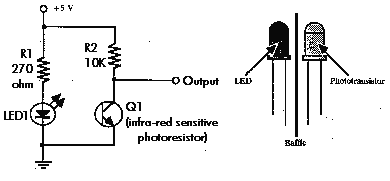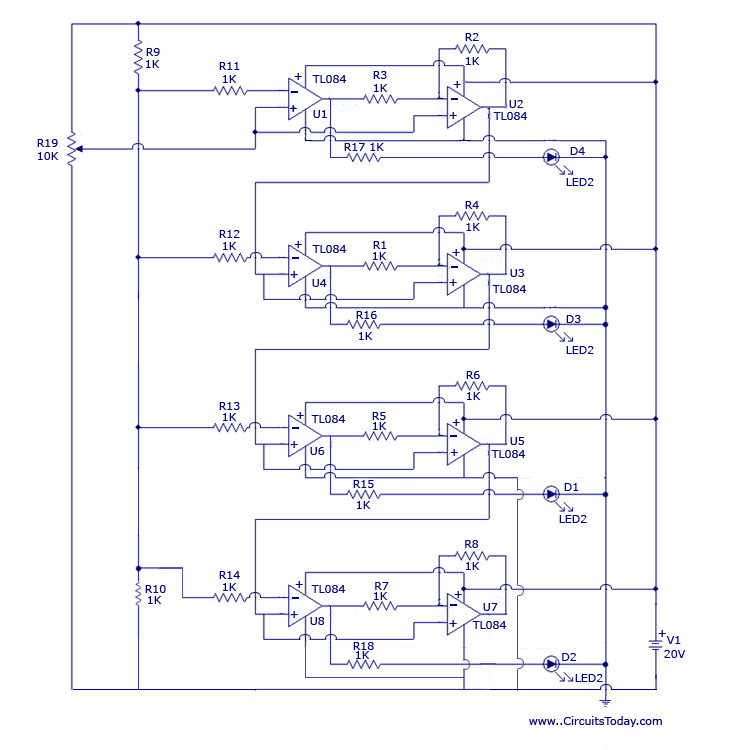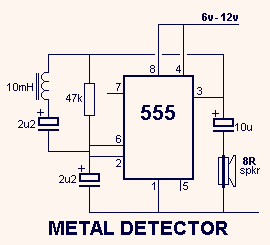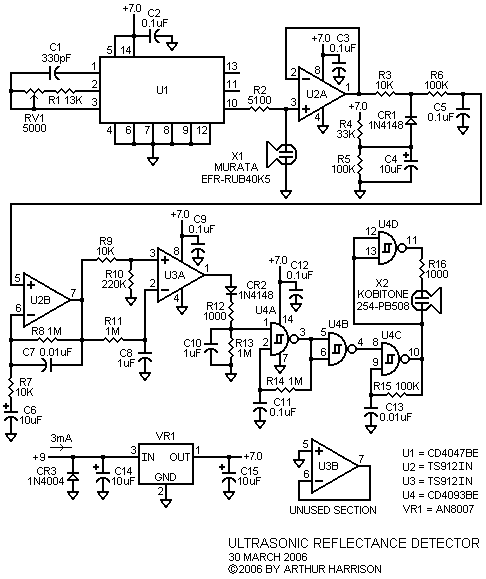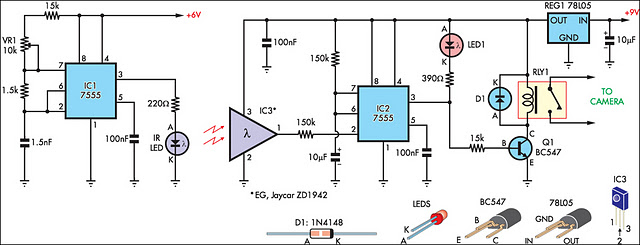
Metal detector with CD4011
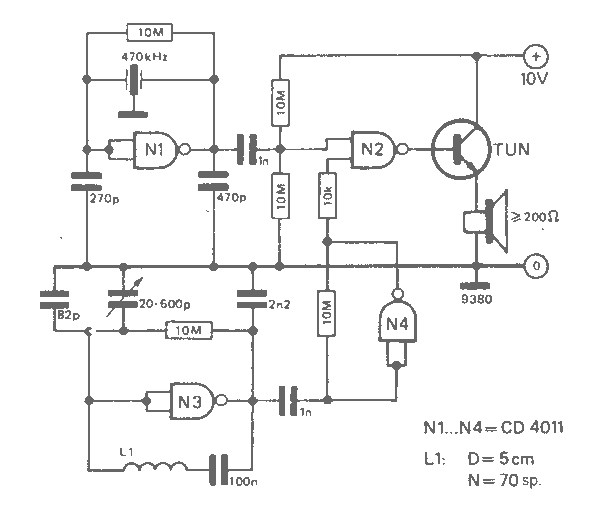
The working principle of this cheap and easy to build metal detector circuit consists in mixing two equal frequencies which causes a low-frequency interference. When one of the oscillators become unstable then the frequency of the interference will be modified. The metal detector circuit is built with CD4011. The oscillator is built with NAND N1 and a ceramic filter of intermediary freq. (470kHz). The second oscillator is with N3 and a LC combination. The freq. of this osc. is adjusted in such way that will produce an audible oscillation of both freqs. Thru N4, the signal from the variable osc. is amplified. If the sensor coil L1 is closer to a metal object then it will modify the auto-induction of the coil, the osc. is unbalanced and the sound will modify. The metal detectors coil is made of: 70 turns of enamelled copper with diam. of 0.3-0.6 mm on a 5 cm diam.
The described metal detector circuit operates on the principle of frequency modulation and interference, utilizing two oscillators to create a detectable signal when in proximity to metallic objects. The primary oscillator, constructed from NAND gate N1, generates a stable frequency of 470 kHz, facilitated by a ceramic filter. This frequency serves as a reference for the second oscillator, which is formed with NAND gate N3 and an inductor-capacitor (LC) combination. The LC circuit is tuned to produce a frequency that, when mixed with the reference frequency, results in an audible beat frequency that can be detected by the user.
The output from the variable oscillator is routed through NAND gate N4, where the signal is amplified to ensure sufficient strength for detection. The critical component of the system is the sensor coil, designated as L1, composed of 70 turns of enameled copper wire with a diameter ranging from 0.3 mm to 0.6 mm, wound around a core with a diameter of 5 cm. This coil acts as an inductor and is sensitive to changes in its magnetic field caused by nearby metallic objects. When the coil approaches a metal object, the change in auto-induction alters the oscillation balance, resulting in a variation in the output sound. This audible signal indicates the presence of metal, allowing the user to identify potential targets effectively.
The design emphasizes simplicity and cost-effectiveness, making it accessible for hobbyists and educational purposes. The use of CD4011 integrated circuits and readily available components further enhances the feasibility of constructing this metal detector. The circuit can be powered by a standard battery, ensuring portability and ease of use in various environments. Overall, this metal detector represents an effective application of basic electronic principles to achieve practical functionality in detecting metallic objects.The working principle of this cheap and easy to build metal detector circuit consists in mixing two equal frequencies which causes a low-frequency interference. When one of the oscillators become unstable then the frenquency of the interference will be modified.
The metal detector circuit is built with CD4011. The oscillator is built with NAND N1 and a ceramic filter of intermediary freq. (470kHz). The second oscillator is with N3 and a LC combination. The freq. of this osc. is adjusted in such way that will produce an audible oscillation of both freqs. Thru N4, the signal from the variable osc. is amplified. If the sensor coil L1 is closer to a metal object then it will modify the auto-induction of the coil, the osc. is unbalanced and the sound will modify. The metal detectors coil is made of: 70 turns of enamelled copper with diam. of 0.3-0.6 mm on a 5 cm diam. 🔗 External reference
The described metal detector circuit operates on the principle of frequency modulation and interference, utilizing two oscillators to create a detectable signal when in proximity to metallic objects. The primary oscillator, constructed from NAND gate N1, generates a stable frequency of 470 kHz, facilitated by a ceramic filter. This frequency serves as a reference for the second oscillator, which is formed with NAND gate N3 and an inductor-capacitor (LC) combination. The LC circuit is tuned to produce a frequency that, when mixed with the reference frequency, results in an audible beat frequency that can be detected by the user.
The output from the variable oscillator is routed through NAND gate N4, where the signal is amplified to ensure sufficient strength for detection. The critical component of the system is the sensor coil, designated as L1, composed of 70 turns of enameled copper wire with a diameter ranging from 0.3 mm to 0.6 mm, wound around a core with a diameter of 5 cm. This coil acts as an inductor and is sensitive to changes in its magnetic field caused by nearby metallic objects. When the coil approaches a metal object, the change in auto-induction alters the oscillation balance, resulting in a variation in the output sound. This audible signal indicates the presence of metal, allowing the user to identify potential targets effectively.
The design emphasizes simplicity and cost-effectiveness, making it accessible for hobbyists and educational purposes. The use of CD4011 integrated circuits and readily available components further enhances the feasibility of constructing this metal detector. The circuit can be powered by a standard battery, ensuring portability and ease of use in various environments. Overall, this metal detector represents an effective application of basic electronic principles to achieve practical functionality in detecting metallic objects.The working principle of this cheap and easy to build metal detector circuit consists in mixing two equal frequencies which causes a low-frequency interference. When one of the oscillators become unstable then the frenquency of the interference will be modified.
The metal detector circuit is built with CD4011. The oscillator is built with NAND N1 and a ceramic filter of intermediary freq. (470kHz). The second oscillator is with N3 and a LC combination. The freq. of this osc. is adjusted in such way that will produce an audible oscillation of both freqs. Thru N4, the signal from the variable osc. is amplified. If the sensor coil L1 is closer to a metal object then it will modify the auto-induction of the coil, the osc. is unbalanced and the sound will modify. The metal detectors coil is made of: 70 turns of enamelled copper with diam. of 0.3-0.6 mm on a 5 cm diam. 🔗 External reference
